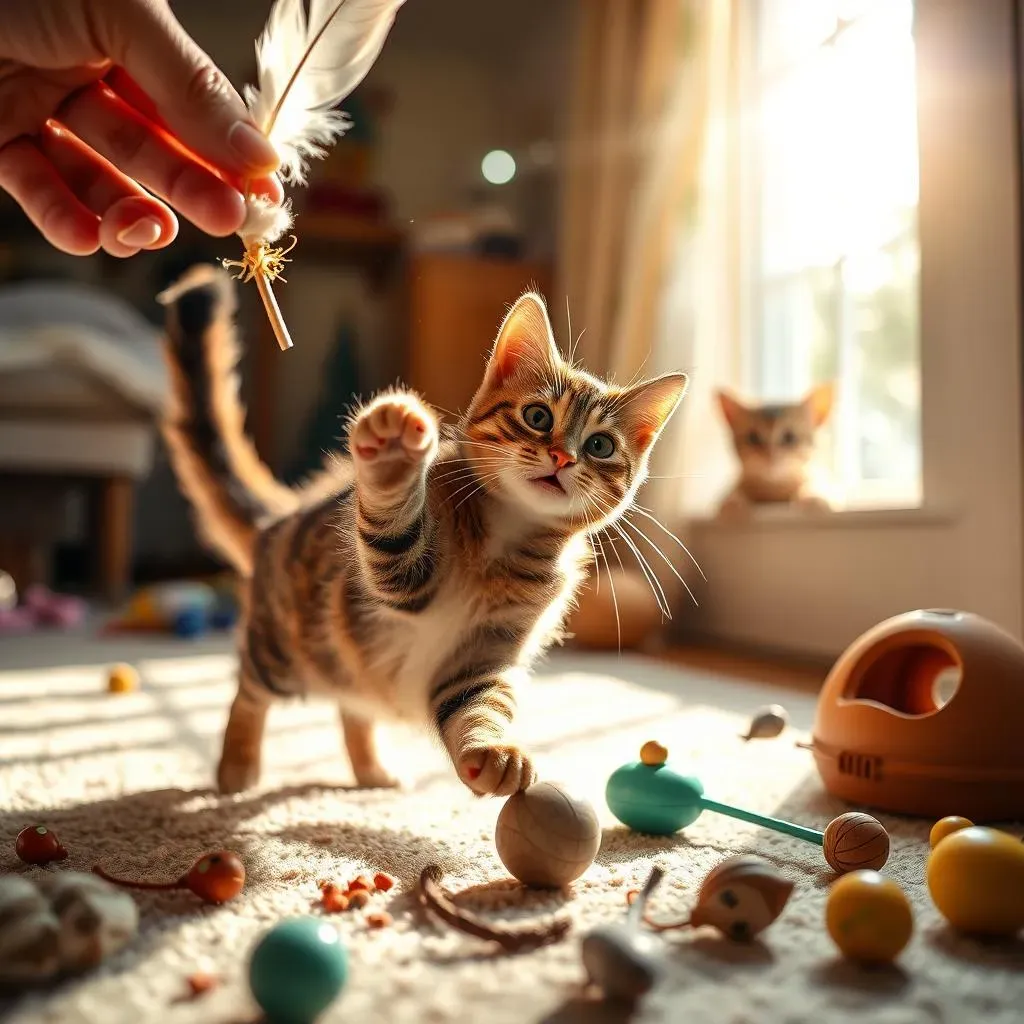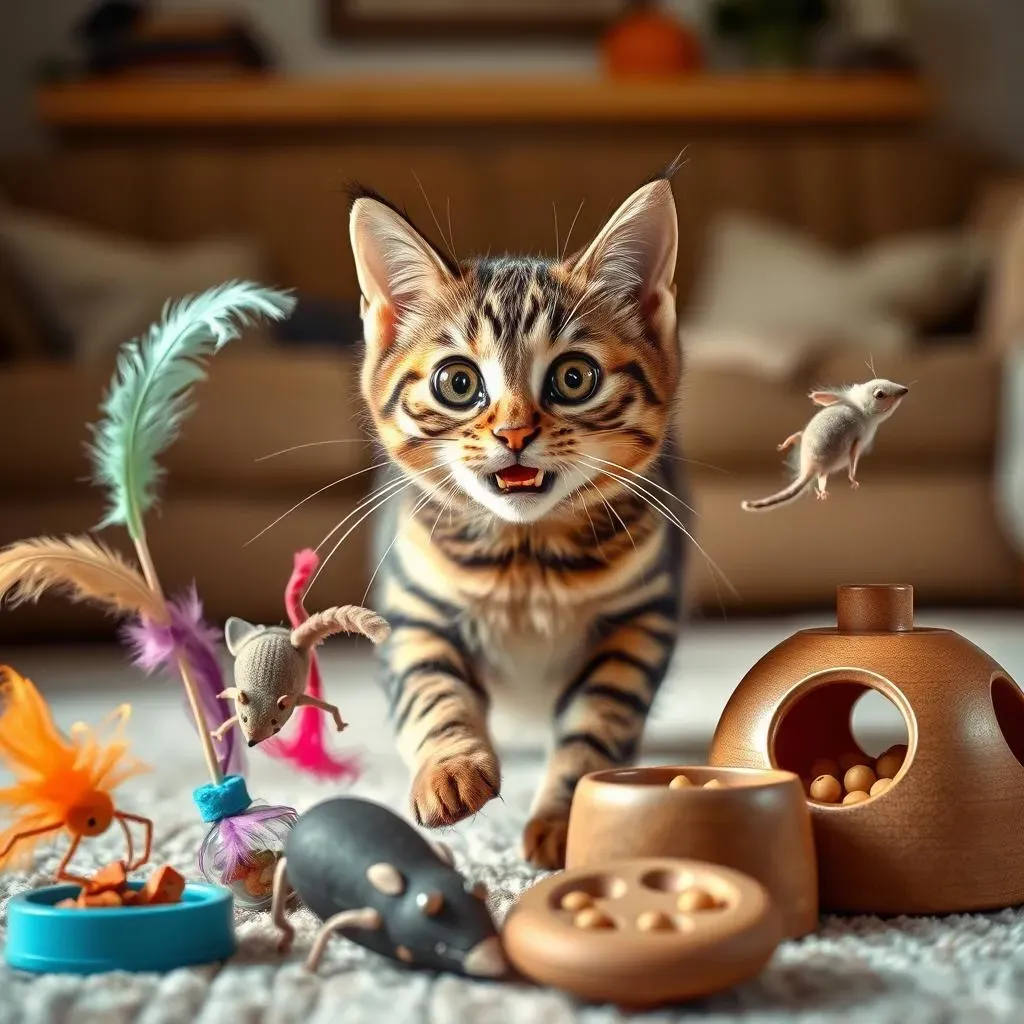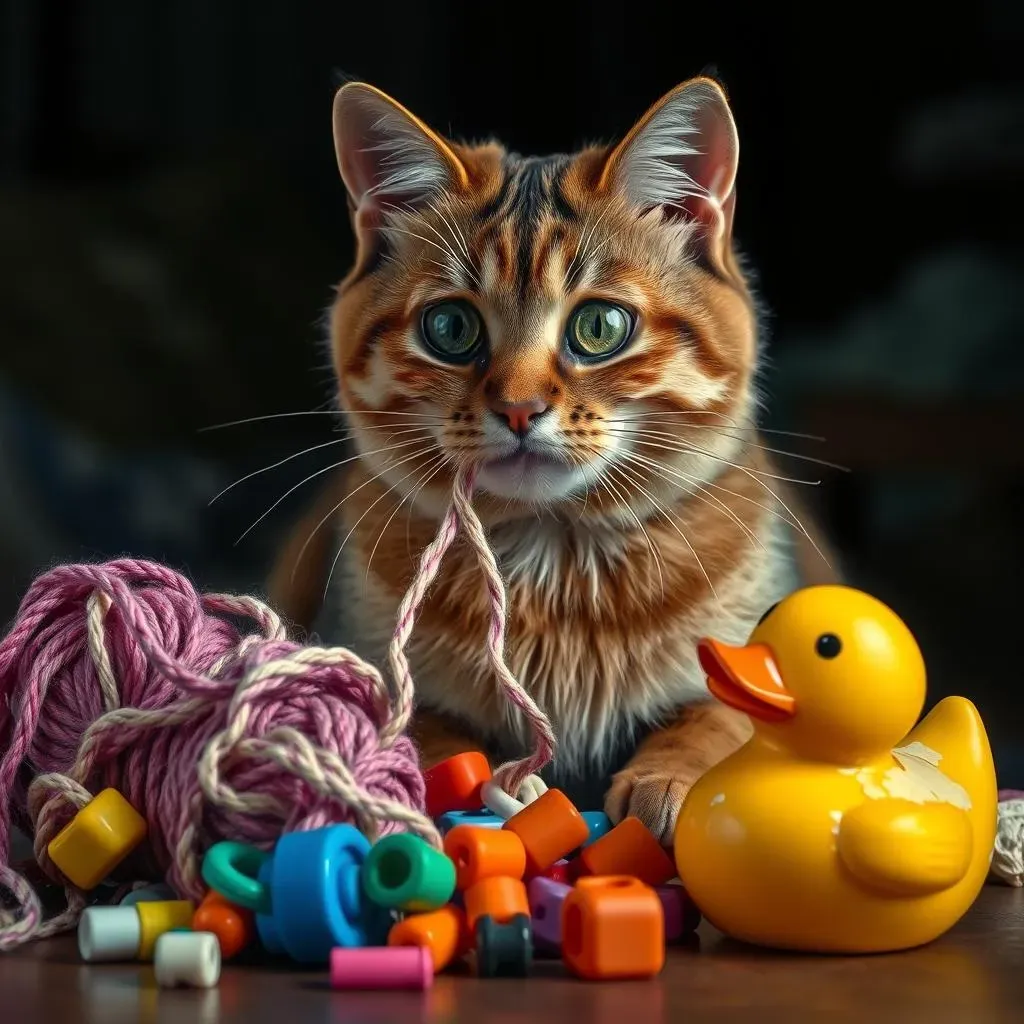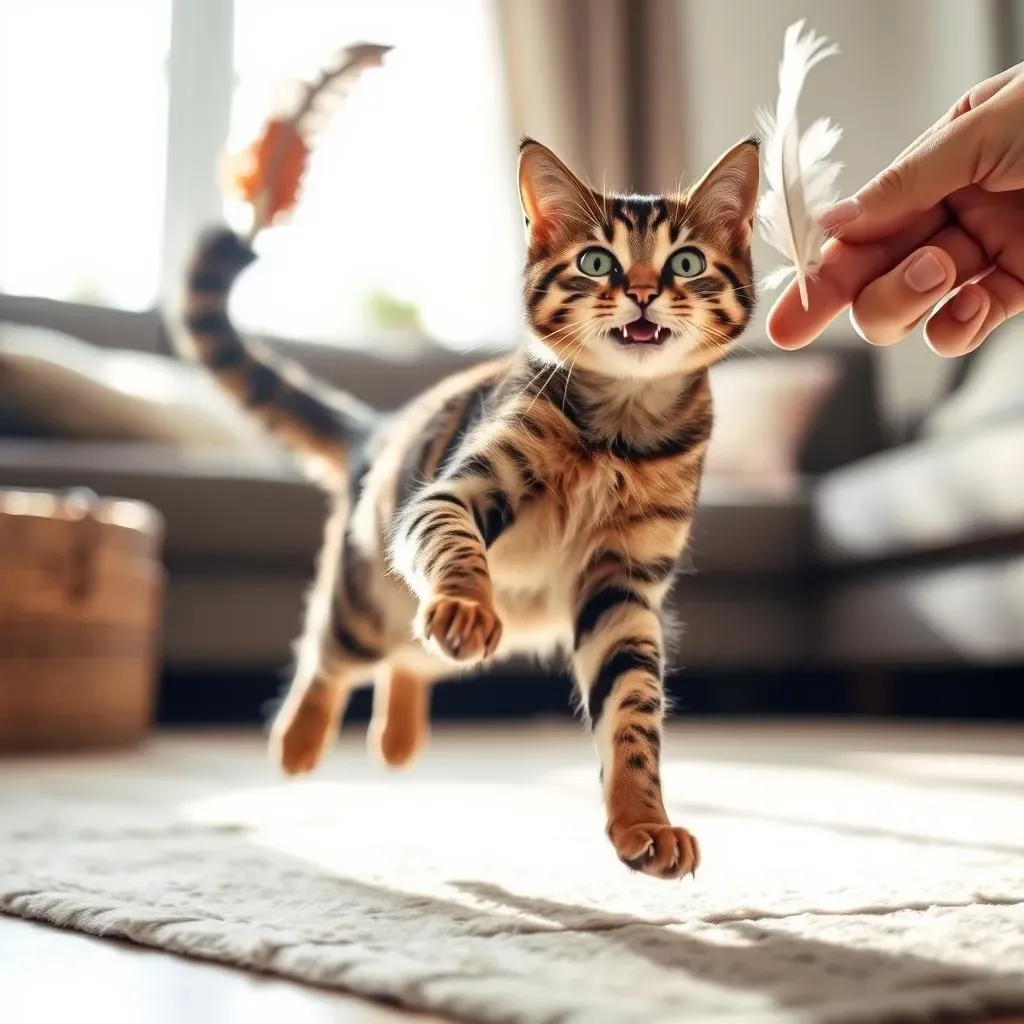Table of Contents
Ever wondered what cat toys do cats like the most? Cats, those enigmatic creatures, need more than just food and shelter. Toys are vital for their physical and mental well-being. A bored cat can quickly become a destructive cat, turning your furniture into their personal scratching post. But fear not! Choosing the right toys can transform your home into a feline paradise, keeping your kitty happy, healthy, and out of trouble. This guide dives deep into the world of cat toys, helping you understand your cat's unique play style. We'll explore which toys tap into their natural hunting instincts, which ones to avoid for safety reasons, and how to engage your cat in fun, interactive play sessions. Get ready to unlock the secrets to a purr-fectly playful life for your beloved feline friend. Let's explore the captivating world of cat toys and discover what makes your kitty tick!
Why Do Cats Need Toys?

Why Do Cats Need Toys?
#1: Physical Health and Exercise
It's easy to think cats spend their days just napping in sunbeams, but they actually need regular physical activity. Toys provide a way for cats to exercise, burn calories, and maintain a healthy weight. Obesity is a serious issue for indoor cats, leading to a host of health problems like diabetes and joint pain. Toys encourage movement, mimicking the hunting behaviors they would naturally engage in outdoors. Without toys, cats may become lethargic and prone to weight gain.
Think of a feather wand as a stand-in for a bird your cat would stalk in the wild. Chasing, pouncing, and batting all contribute to their physical fitness. Even a simple ball can get them moving! The key is to find toys that spark their interest and get them active. We all know a lazy cat is not a healthy cat.
#2: Mental Stimulation and Enrichment
A cat's mind is just as important as its body. Toys provide mental stimulation, preventing boredom and frustration. Cats are intelligent creatures with natural instincts to hunt, explore, and investigate. Without an outlet for these instincts, they can become bored, anxious, or even depressed. Toys offer a way to satisfy these needs in a safe and controlled environment.
Interactive toys, puzzle feeders, and even simple cardboard boxes can provide hours of entertainment and mental enrichment. A cat who's mentally stimulated is less likely to develop behavioral problems like excessive meowing, scratching, or aggression. I remember when I introduced a puzzle feeder to my cat, Whiskers, she was immediately engaged and spent a good portion of the afternoon trying to get the treats out. It was a joy to watch her problem-solving skills in action!
What Kind of Cat Toys Do Cats Like?

What Kind of Cat Toys Do Cats Like?
Hunting Toys: Unleashing the Inner Predator
If you want to really engage your cat, tap into their natural hunting instincts! Think about what cats do in the wild: stalk, chase, pounce, and capture prey. Toys that mimic these actions are almost always a hit. Feather wands are classic for a reason – the fluttering feathers trigger their chase response. Toy mice, especially those filled with catnip, are also irresistible. The key is movement. Drag the toy across the floor, make it dart and hide, and let your cat stalk and pounce.
Laser pointers are another popular option, but use them responsibly. Never shine the laser in their eyes, and always end the play session with a "capture." Let them pounce on a physical toy or treat at the end so they don't get frustrated by never actually catching anything. Also, consider rotating toys to keep things fresh and exciting. If you leave the same toys out all the time, your cat will eventually lose interest. Keep a stash of toys and introduce them one at a time, swapping them out every few days or weeks.
There are several options for hunting toys, such as:
- Feather wands
- Toy mice
- Laser pointers
- Interactive feeders
Interactive Toys and Puzzle Feeders: Brain Games for Cats
Don't underestimate the power of a good brain teaser! Interactive toys and puzzle feeders challenge your cat mentally, keeping them engaged and preventing boredom. These toys require your cat to solve a problem to get a reward, such as a treat or kibble. Puzzle feeders come in various forms, from simple balls with holes to more complex contraptions with sliding panels and hidden compartments. These toys are a great way to slow down fast eaters and provide mental stimulation at the same time.
I've found that interactive toys are especially beneficial for indoor cats who may not have as many opportunities to explore and hunt as outdoor cats. They provide a sense of accomplishment and satisfaction, which can reduce stress and anxiety. Consider toys that crinkle, make noise, or have different textures to further stimulate their senses. A crinkle ball is a simple toy that many cats adore because of the sound and feel. Remember, variety is the spice of life, even for cats!
Here's a tip: If your cat is new to puzzle feeders, start with an easy one and gradually increase the difficulty as they get the hang of it. You want to challenge them, not frustrate them!
Cat Toys You Should Absolutely Avoid

Cat Toys You Should Absolutely Avoid
String, Yarn, and Ribbon: Silent Dangers
These seemingly harmless materials pose a significant threat to your cat's health. Cats love to play with string-like objects, but if ingested, they can cause serious intestinal blockages. Because of their tongue's barbs, cats cannot easily spit out stringy materials once they start swallowing them. The string can then wrap around their intestines, causing a linear foreign body obstruction. This condition often requires surgery to correct and can be life-threatening. I once had a friend whose cat needed emergency surgery after swallowing a piece of yarn. It was a stressful and expensive experience, and thankfully, the cat recovered, but it's a risk you absolutely want to avoid.
Small Parts and Breakable Toys: Choking Hazards
Toys with small parts that can be easily chewed off and swallowed are another major concern. Buttons, beads, plastic eyes, and other small decorations can become choking hazards or cause internal blockages if ingested. Always inspect toys carefully before giving them to your cat, and regularly check for any signs of damage. If a toy is starting to fall apart, throw it away immediately. Better safe than sorry! I always recommend buying toys that are specifically designed for cats and made from durable, non-toxic materials.
Toys Made with Toxic Materials: Health Risks
Some toys are made with materials that can be harmful to your cat if ingested. Certain plastics, paints, and dyes can contain toxic chemicals that can cause illness or even death. Avoid toys made from cheap or unknown materials, and always look for toys that are labeled as non-toxic and safe for pets. If you're unsure about a particular toy, it's best to err on the side of caution and choose a different option. Your cat's health is worth the extra effort! I would recommend researching brands and reading reviews before purchasing to ensure the product is safe.
Here is a table of what toys you should avoid:
Toy Type | Reason to Avoid |
|---|---|
String, Yarn, Ribbon | Intestinal Blockage |
Toys with Small Parts | Choking Hazard |
Toys with Toxic Materials | Poisoning |
How to Play With Your Cat: Maximizing Fun

How to Play With Your Cat: Maximizing Fun
Mimic Prey Behavior: The Art of the Tease
To truly engage your cat, you've got to think like a mouse, bird, or bug! Mimic the way prey moves in the wild. Use slow, deliberate movements to build anticipation, then suddenly dart and dash to trigger their chase response. Hide the toy behind furniture or under blankets to create a sense of mystery and intrigue. Vary your movements and speed to keep your cat guessing and interested. The key is to make the toy irresistible. I like to make the toy "hide" and "peek" from behind corners, just like a real mouse would. It drives my cat wild!
Don't just wave the toy in their face – that's boring! Instead, drag it across the floor, make it flutter in the air, or let it disappear and reappear. Remember, cats are natural hunters, so appeal to their instincts. Change up the toys often and try different objects that are not toys. I once saw a cat play with a bottle cap for hours!
Let Them "Catch" the Prey: Satisfaction Guaranteed
While it's fun to tease your cat, it's important to let them "catch" the toy occasionally. Imagine how frustrating it would be to chase something endlessly without ever succeeding! Allowing your cat to capture the toy provides a sense of accomplishment and satisfaction, reinforcing their hunting behavior. After a good chase, let them pounce on the toy and hold it for a few moments. This gives them a chance to feel like they've actually caught something, which is incredibly rewarding for them. If you're using a laser pointer, always end the session by shining the laser on a physical toy or treat so they can "catch" something tangible.
It's also a good idea to vary the "catch" rate. Sometimes let them catch the toy quickly, and other times make them work for it a little harder. This keeps them engaged and prevents them from getting bored. I usually let my cat catch the toy about 75% of the time. It is important to keep it fun for both of you!
Play Style | Description |
|---|---|
Mimic Prey | Use realistic movements to simulate hunting. |
Vary Speed | Alternate between slow and fast movements. |
Let Them Catch | Allow your cat to capture the toy occasionally. |
Keeping Your Cat Safe: Inspecting and Maintaining Toys

Keeping Your Cat Safe: Inspecting and Maintaining Toys
Regular Inspections: A Must-Do
so you've got a fantastic collection of toys for your cat, that's great! But it's not enough to just buy them and let your cat go wild. You need to regularly inspect those toys for wear and tear. I'm talking about checking for loose parts, frayed edges, or any signs of damage. A small tear in a plush toy can quickly turn into a gaping hole, and those stuffing materials can be a choking hazard. A broken plastic toy can have sharp edges that could cut your cat's mouth or paws. It is vital to check the toys frequently.
Make it a habit to do a quick toy check every few days. Run your fingers over the toys, give them a little tug, and look for anything that seems out of place. Pay special attention to seams, glued-on parts, and any areas that your cat seems to chew on a lot. If you spot any damage, don't hesitate to toss the toy. It's not worth the risk of your cat getting hurt. I usually check the toys when I am cleaning the house, that way I can keep the area tidy as well.
Cleaning and Sanitizing: Keeping Germs at Bay
Just like any other item in your house, cat toys can get dirty and accumulate bacteria. Think about it – your cat is dragging them across the floor, batting them around, and maybe even drooling on them. All of that can create a breeding ground for germs. Regularly cleaning and sanitizing your cat's toys is important for their health and hygiene. Soft toys can usually be machine washed on a gentle cycle. Just be sure to use a pet-safe detergent and avoid using any fabric softeners or bleach. For plastic or rubber toys, you can wash them with warm, soapy water and then rinse them thoroughly. Make sure the toys are completely dry before giving them back to your cat. I usually leave them out in the sun to dry, as the sunlight can also help to kill bacteria.
Here's a pro tip: If your cat has a favorite toy that they carry around everywhere, consider washing it more frequently. And if your cat has been sick, it's a good idea to disinfect all of their toys to prevent the spread of infection. I have found that a little vinegar and water works great as a disinfectant.
Toy Maintenance Tip | Description |
|---|---|
Regular Inspections | Check for damage and loose parts every few days. |
Cleaning | Wash soft toys in the machine. Clean plastic toys with soap and water. |
Sanitizing | Use pet-safe disinfectants to kill bacteria. |
Conclusion: Happy Cat, Happy Home
Finding the right toys for your cat is an ongoing adventure. By understanding their preferences, prioritizing safety, and engaging in regular playtime, you'll not only enrich their lives but also strengthen the bond you share. Remember, a stimulated cat is a happy cat, and a happy cat makes for a happy home. So, experiment with different toys, observe your cat's reactions, and get ready to unleash their inner hunter. Your feline friend will thank you for it with purrs, head boops, and endless entertainment!